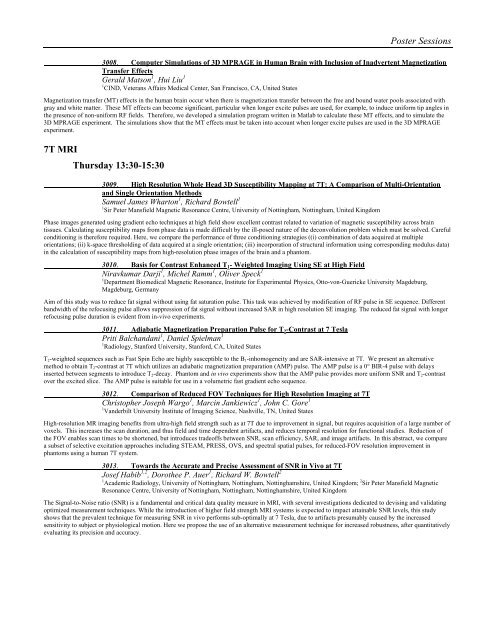TRADITIONAL POSTER - ismrm
TRADITIONAL POSTER - ismrm
TRADITIONAL POSTER - ismrm
Create successful ePaper yourself
Turn your PDF publications into a flip-book with our unique Google optimized e-Paper software.
Poster Sessions<br />
3008. Computer Simulations of 3D MPRAGE in Human Brain with Inclusion of Inadvertent Magnetization<br />
Transfer Effects<br />
Gerald Matson 1 , Hui Liu 1<br />
1 CIND, Veterans Affairs Medical Center, San Francisco, CA, United States<br />
Magnetization transfer (MT) effects in the human brain occur when there is magnetization transfer between the free and bound water pools associated with<br />
gray and white matter. These MT effects can become significant, particular when longer excite pulses are used, for example, to induce uniform tip angles in<br />
the presence of non-uniform RF fields. Therefore, we developed a simulation program written in Matlab to calculate these MT effects, and to simulate the<br />
3D MPRAGE experiment. The simulations show that the MT effects must be taken into account when longer excite pulses are used in the 3D MPRAGE<br />
experiment.<br />
7T MRI<br />
Thursday 13:30-15:30<br />
3009. High Resolution Whole Head 3D Susceptibility Mapping at 7T: A Comparison of Multi-Orientation<br />
and Single Orientation Methods<br />
Samuel James Wharton 1 , Richard Bowtell 1<br />
1 Sir Peter Mansfield Magnetic Resonance Centre, University of Nottingham, Nottingham, United Kingdom<br />
Phase images generated using gradient echo techniques at high field show excellent contrast related to variation of magnetic susceptibility across brain<br />
tissues. Calculating susceptibility maps from phase data is made difficult by the ill-posed nature of the deconvolution problem which must be solved. Careful<br />
conditioning is therefore required. Here, we compare the performance of three conditioning strategies ((i) combination of data acquired at multiple<br />
orientations; (ii) k-space thresholding of data acquired at a single orientation; (iii) incorporation of structural information using corresponding modulus data)<br />
in the calculation of susceptibility maps from high-resolution phase images of the brain and a phantom.<br />
3010. Basis for Contrast Enhanced T 1 - Weighted Imaging Using SE at High Field<br />
Niravkumar Darji 1 , Michel Ramm 1 , Oliver Speck 1<br />
1 Department Biomedical Magnetic Resonance, Institute for Experimental Physics, Otto-von-Guericke University Magdeburg,<br />
Magdeburg, Germany<br />
Aim of this study was to reduce fat signal without using fat saturation pulse. This task was achieved by modification of RF pulse in SE sequence. Different<br />
bandwidth of the refocusing pulse allows suppression of fat signal without increased SAR in high resolution SE imaging. The reduced fat signal with longer<br />
refocusing pulse duration is evident from in-vivo experiments.<br />
3011. Adiabatic Magnetization Preparation Pulse for T 2 -Contrast at 7 Tesla<br />
Priti Balchandani 1 , Daniel Spielman 1<br />
1 Radiology, Stanford University, Stanford, CA, United States<br />
T 2 -weighted sequences such as Fast Spin Echo are highly susceptible to the B 1 -inhomogeneity and are SAR-intensive at 7T. We present an alternative<br />
method to obtain T 2 -contrast at 7T which utilizes an adiabatic magnetization preparation (AMP) pulse. The AMP pulse is a 0° BIR-4 pulse with delays<br />
inserted between segments to introduce T 2 -decay. Phantom and in vivo experiments show that the AMP pulse provides more uniform SNR and T 2 -contrast<br />
over the excited slice. The AMP pulse is suitable for use in a volumetric fast gradient echo sequence.<br />
3012. Comparison of Reduced FOV Techniques for High Resolution Imaging at 7T<br />
Christopher Joseph Wargo 1 , Marcin Jankiewicz 1 , John C. Gore 1<br />
1 Vanderbilt University Institute of Imaging Science, Nashville, TN, United States<br />
High-resolution MR imaging benefits from ultra-high field strength such as at 7T due to improvement in signal, but requires acquisition of a large number of<br />
voxels. This increases the scan duration, and thus field and time dependent artifacts, and reduces temporal resolution for functional studies. Reduction of<br />
the FOV enables scan times to be shortened, but introduces tradeoffs between SNR, scan efficiency, SAR, and image artifacts. In this abstract, we compare<br />
a subset of selective excitation approaches including STEAM, PRESS, OVS, and spectral spatial pulses, for reduced-FOV resolution improvement in<br />
phantoms using a human 7T system.<br />
3013. Towards the Accurate and Precise Assessment of SNR in Vivo at 7T<br />
Josef Habib 1,2 , Dorothee P. Auer 1 , Richard W. Bowtell 2<br />
1 Academic Radiology, University of Nottingham, Nottingham, Nottinghamshire, United Kingdom; 2 Sir Peter Mansfield Magnetic<br />
Resonance Centre, University of Nottingham, Nottingham, Nottinghamshire, United Kingdom<br />
The Signal-to-Noise ratio (SNR) is a fundamental and critical data quality measure in MRI, with several investigations dedicated to devising and validating<br />
optimized measurement techniques. While the introduction of higher field strength MRI systems is expected to impact attainable SNR levels, this study<br />
shows that the prevalent technique for measuring SNR in vivo performs sub-optimally at 7 Tesla, due to artifacts presumably caused by the increased<br />
sensitivity to subject or physiological motion. Here we propose the use of an alternative measurement technique for increased robustness, after quantitatively<br />
evaluating its precision and accuracy.















